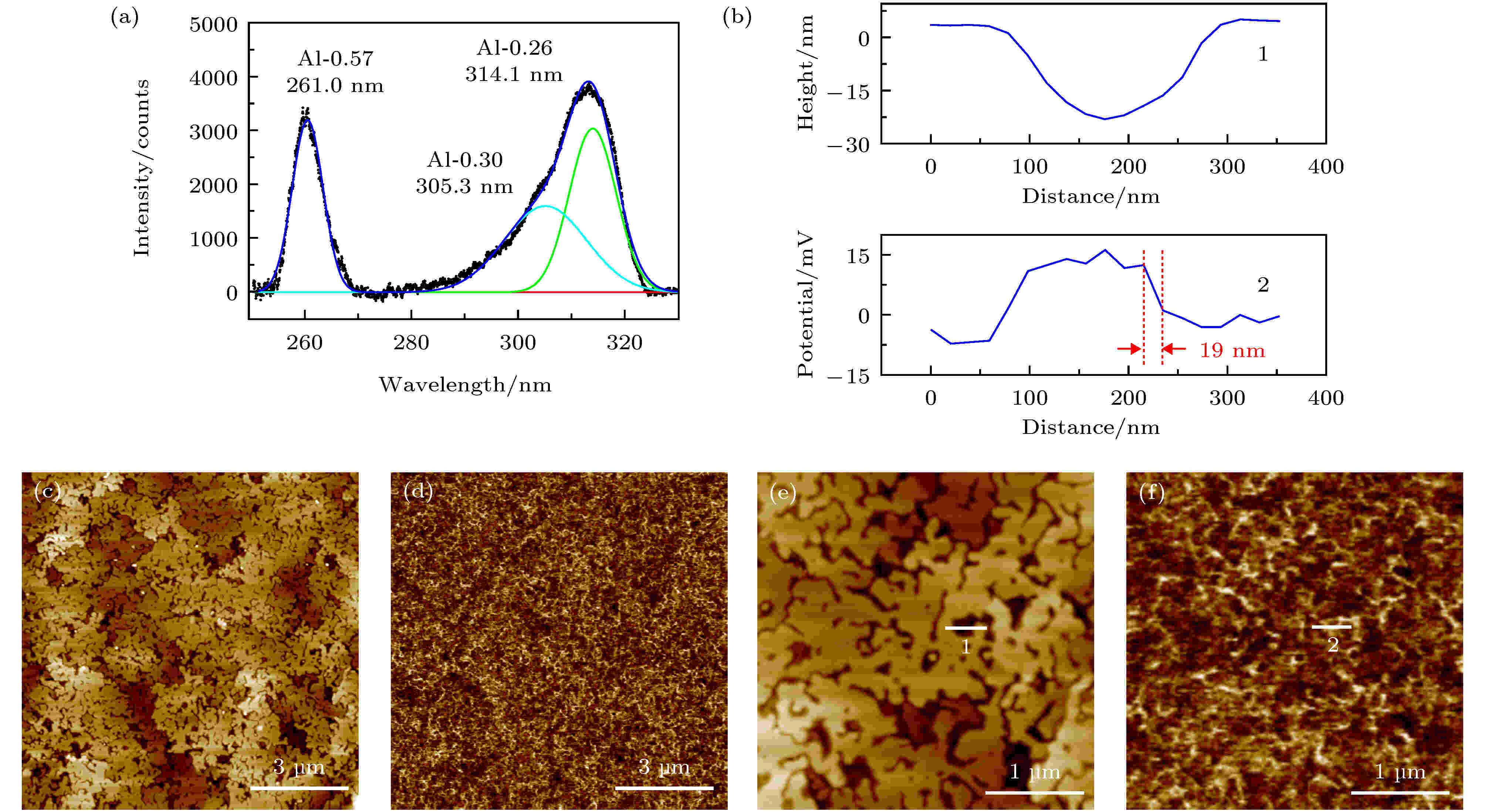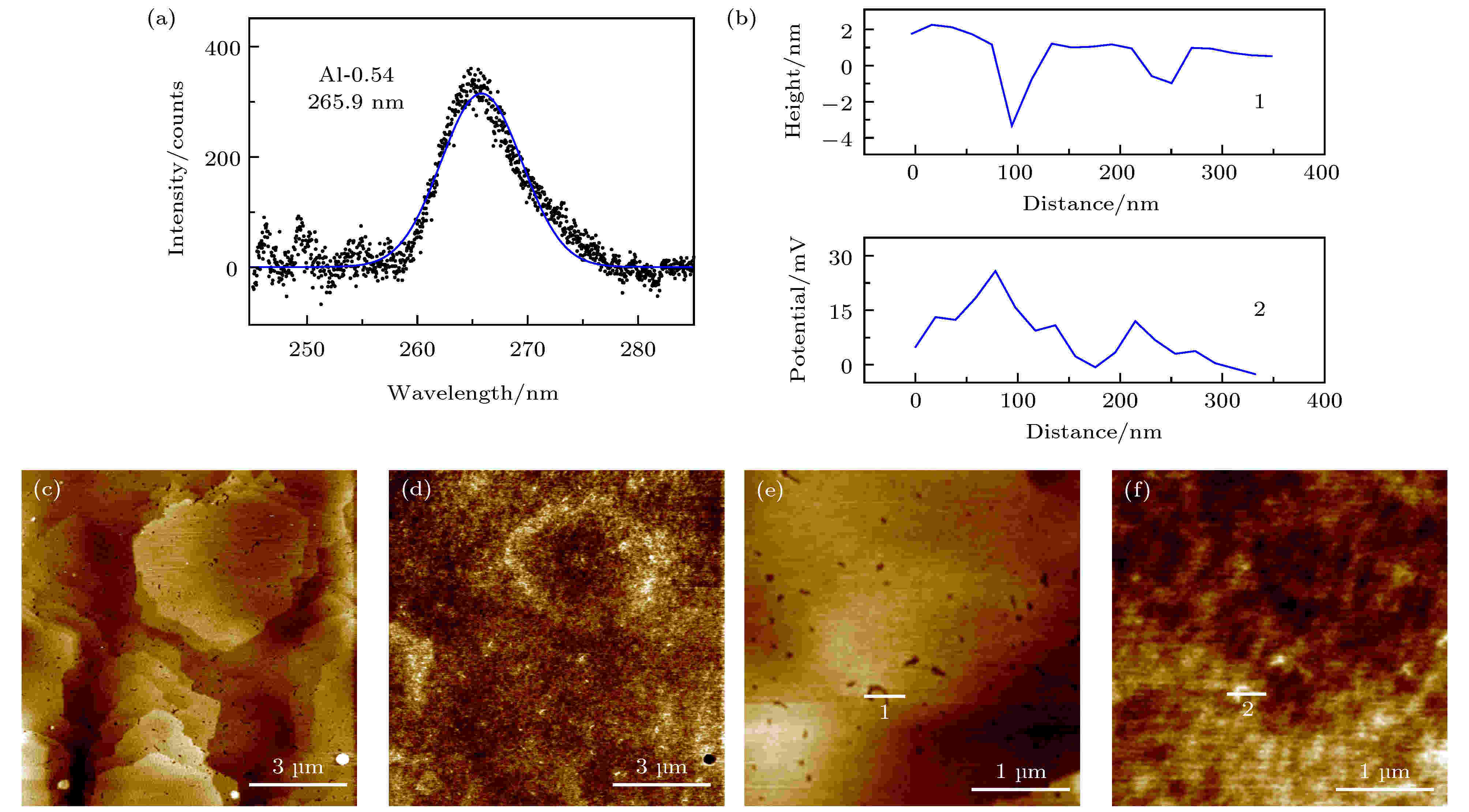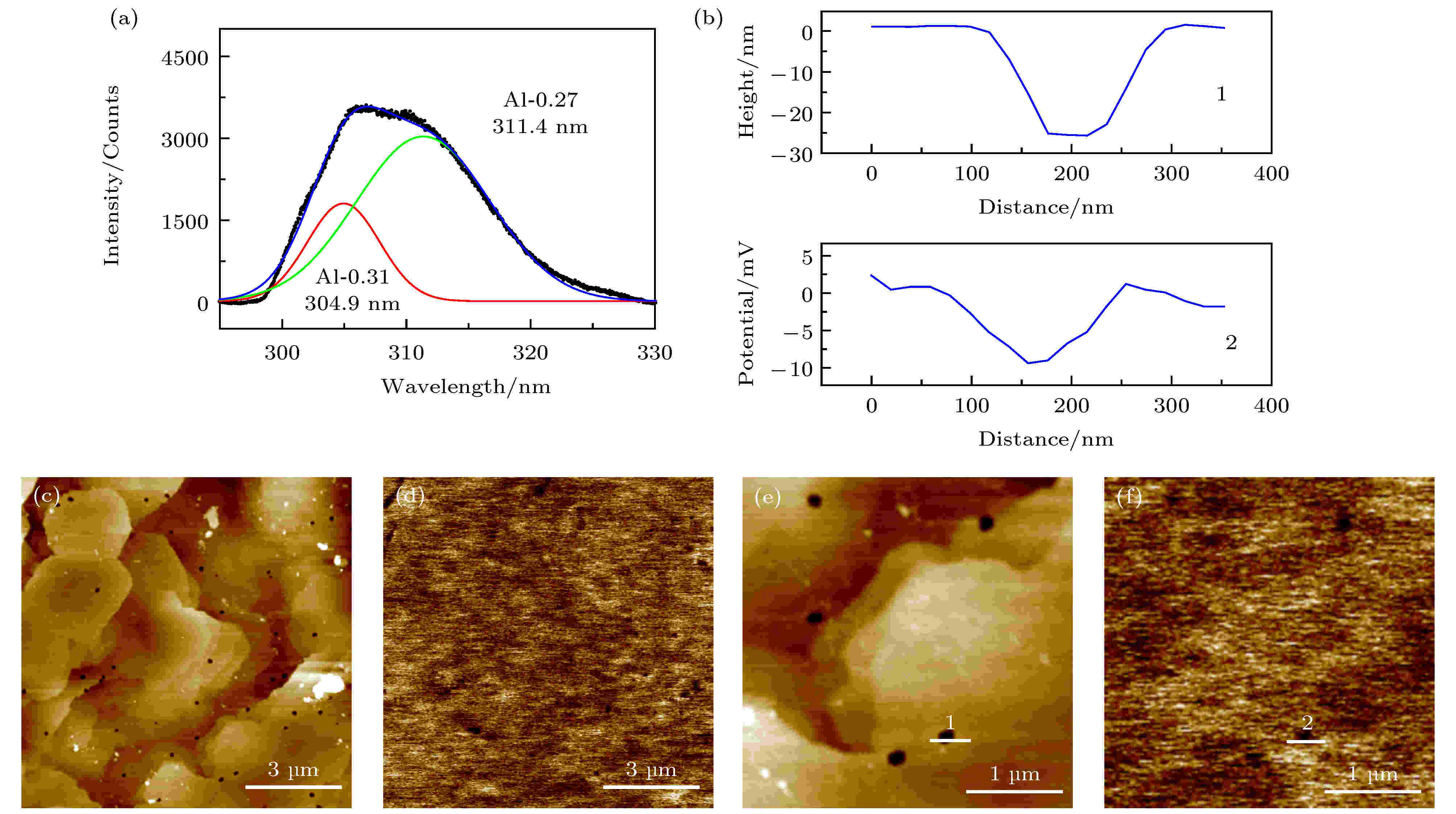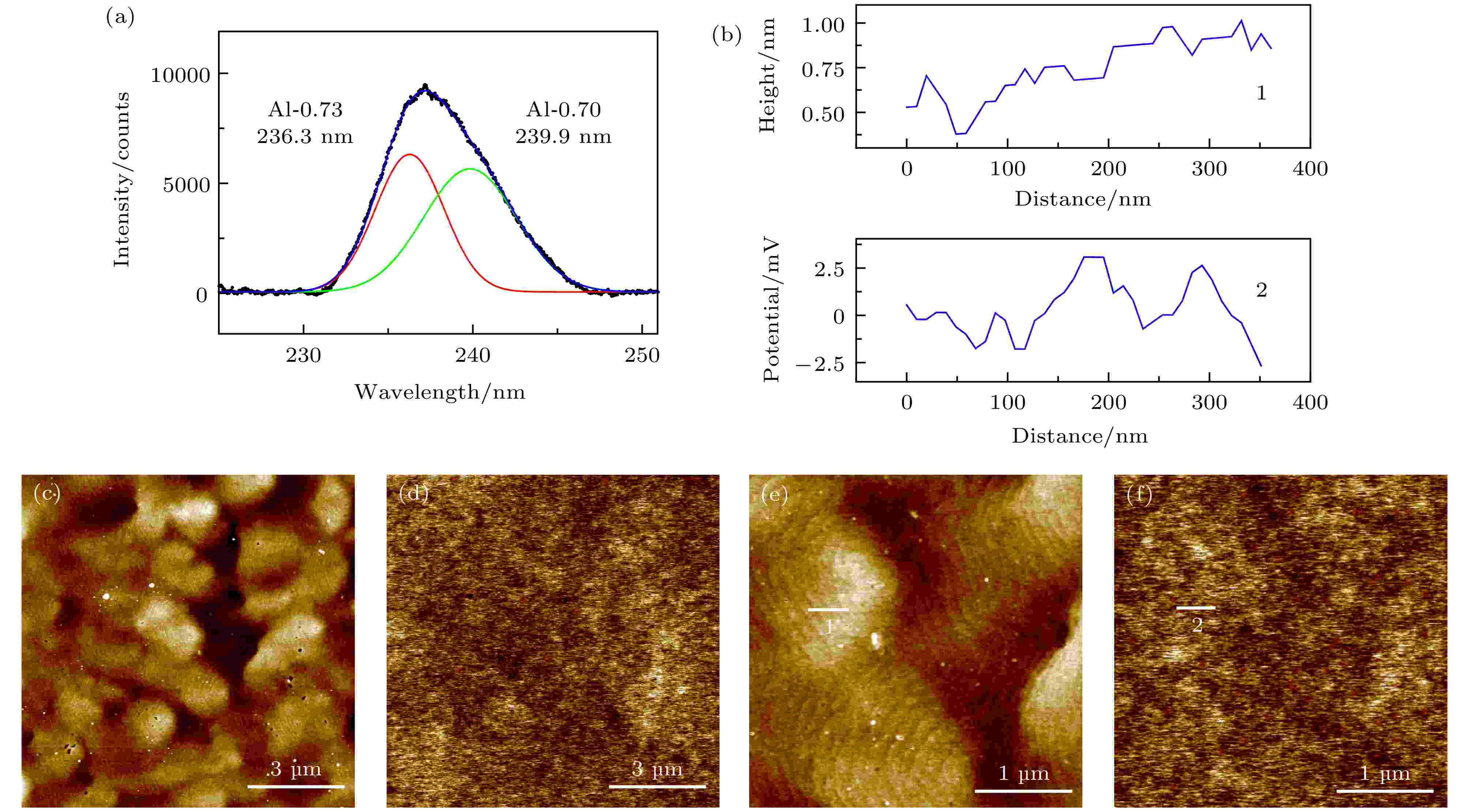全文HTML
--> --> -->本文采用了同位的共聚焦微区荧光光谱和扫描开尔文探针显微术对不同Al组分的AlGaN表面相分离现象进行了表征. 其中采用的基于双频锁相的单次扫描开尔文探针显微术[20], 可将表面电势的分辨率提高到小于10 nm. 在微区光谱中出现相分离现象的区域, 利用此方法获得的表面电势像可以清晰地观察到犬牙交错的台阶及其表面凹坑边缘的电势变化, 对应于组分的不均匀性. 随着台阶转入台阶流的形态, 凹坑逐渐缩小和合并, 台阶和凹坑边缘不再出现明显的电势畴界, 光谱中相分离的现象消失. 实验结果表明, 结合同位微区荧光光谱, 高分辨的扫描开尔文探针显微术是一种有效的表征AlGaN相分离微观机制的方法.
 图 1 (a) Al0.3Ga0.7N样品剖面的SEM图; (b) Al0.5Ga0.5N样品剖面的SEM图; (c) Al0.7Ga0.3N样品剖面的SEM图; (a), (b)和(c)图中分别用红框和黄框标记了AlGaN层与AlN层的位置, 并在框中显示了测量得到的厚度; (d)中从左至右分别为Al0.3Ga0.7N, Al0.5Ga0.5N和Al0.7Ga0.3N样品利用椭偏仪测量得到的吸收系数拟合带隙的结果
图 1 (a) Al0.3Ga0.7N样品剖面的SEM图; (b) Al0.5Ga0.5N样品剖面的SEM图; (c) Al0.7Ga0.3N样品剖面的SEM图; (a), (b)和(c)图中分别用红框和黄框标记了AlGaN层与AlN层的位置, 并在框中显示了测量得到的厚度; (d)中从左至右分别为Al0.3Ga0.7N, Al0.5Ga0.5N和Al0.7Ga0.3N样品利用椭偏仪测量得到的吸收系数拟合带隙的结果Figure1. (a) The SEM image of the Al0.3Ga0.7N Sample; (b) the SEM image of the Al0.5Ga0.5N Sample; (c) the SEM image of the Al0.7Ga0.3N Sample. The AlGaN and AlN layers in (a), (b) and (c) are marked with red and yellow squares respectively, in addition with the thickness labeled. (d) From left to right, the curves show the absorption coefficients of Al0.3Ga0.7N, Al0.5Ga0.5N and Al0.7Ga0.3N samples, respectively. The absorption coefficients are measured by an ellipsometer and the band gaps are fitted out and labeled.
采用椭偏仪对三片样品的吸收系数进行了测量. 椭偏仪型号为J.A.Woollam公司的M-2000DI光谱型椭圆偏振测量仪. 通过拟合椭偏仪测得的反射谱可获得样品的折射率n与消光系数k, 由k获得吸收系数

微区荧光光谱是采用实验室自主研制的一套深紫外共聚焦时间分辨荧光光谱系统获得的, 激发光源为195—300 nm可调节的飞秒脉冲光源, 激光通过25倍反射式物镜聚焦到样品表面, 激发的荧光通过同样的物镜收集后, 通过一系列滤光片, 聚焦到100 μm的针孔后, 被光谱仪接收, 从而获得共聚焦荧光光谱. 该设备的光谱空间分辨率在2 μm左右. 由于三片样品的带隙跨度大, 不同样品的激发波长有所不同: 对于Al0.3Ga0.7N样品采用266 nm波长的脉冲激光, 平均功率约为1 mW; 对于Al0.5Ga0.5N样品采用226 nm波长的脉冲激光, 平均功率约为1.2 mW; 对于Al0.7Ga0.3N样品采用195 nm波长的脉冲激光, 平均功率约为0.5 mW.
表面电势通过Bruker Multimode原子力显微镜扫描获得, 由光学显微镜中的标记点实现与微区荧光光谱的同位测试. 利用我们自主研制和扩展的双频锁相的单次扫描开尔文探针显微术, 可将表面电势的分辨率提高到小于10 nm. 目前应用较广的抬高模式开尔文探针显微术测试表面电势时, 是在第一次形貌扫描的基础上, 将针尖抬高数十纳米, 沿着形貌扫描的轨迹扫描, 同时在导电探针上施加与形貌扫描同频率的交流电压, 通过在针尖上补偿针尖和样品间的电势差, 使得交流电压引起的探针机械振动消失. 针尖上补偿的电势差即为测量得到的表面电势. 而本文中采用的双频锁相的单次扫描方法, 在形貌扫描的同时, 额外采用针尖的第二共振频率施加在导电探针上, 从而实现在单次扫描中同时获得形貌与表面电势像. 由于不需要针尖抬高, 因此电势的空间分辨率可以得到较大的提高[20]. 实验采用Bruker公司的SCM-PIT导电针尖, 形貌测试采用的第一本征频率约为67.04 Hz, 表面电势测试采用的第二本征频率约为420.94 Hz. 在本文对AlGaN样品表面的表征中, 用该方法可以清晰地分辨表面电势的畴界, 典型的空间分辨率可达到约19 nm (详见图2(b)及相关讨论).
 图 2 Al0.5Ga0.5N样品表面有明显相分离现象的区域 (a)该区域的典型荧光光谱; (b)上图和下图分别为形貌和表面电势的剖面图, 对应于图(e)中标记1的位置和图(f)中标记2的位置; 如红线所示, 下图中电势剖面图的下降沿宽度约为19 nm, 说明了我们采用的双频单次扫描开尔文探针显微术的典型空间分辨率; (c)和(d)扫描尺寸为10 μm时的表面形貌像及对应表面电势像; (e) 和 (f)扫描尺寸为3 μm时的表面形貌像及对应表面电势像; 图(e)中白色横线标记1和图(f)中标记2对应同一位置
图 2 Al0.5Ga0.5N样品表面有明显相分离现象的区域 (a)该区域的典型荧光光谱; (b)上图和下图分别为形貌和表面电势的剖面图, 对应于图(e)中标记1的位置和图(f)中标记2的位置; 如红线所示, 下图中电势剖面图的下降沿宽度约为19 nm, 说明了我们采用的双频单次扫描开尔文探针显微术的典型空间分辨率; (c)和(d)扫描尺寸为10 μm时的表面形貌像及对应表面电势像; (e) 和 (f)扫描尺寸为3 μm时的表面形貌像及对应表面电势像; 图(e)中白色横线标记1和图(f)中标记2对应同一位置Figure2. The area with obvious phase separation phenomenon on the Al0.5Ga0.5N sample surface. (a) A typical photoluminescence spectrum of the area. (b) Profiles of the topography and the surface potential shown in plot 1 and 2, respectively. The profile of the topography is extracted from mark 1 in panel (e). The profile of the surface potential is extracted from the mark 2 in panel (f). The width of the falling edge marked by red lines in the profile of the surface potential is about 19 nm. This value presents the typical spatial resolution of the single-pass Kelvin force probe microscopy we applied. (c) and (d) The topography image and the surface potential image, respectively, obtained at the same area with a scan size of 10 μm. (e) and (f) The topography image and the surface potential image, respectively, obtained at the same area with a scan size of 3 μm. The white lines marked by 1 in panel (e) and 2 in panel (f) are picked at the same position.
3.1.带隙拟合和组分估算
图1(d)显示了通过椭偏仪测量得到的吸收系数拟合带隙的结果. AlGaN为直接带隙半导体, 根据Tauc公式[21,22], 吸收系数







2
3.2.Al0.5Ga0.5N的荧光光谱和表面电势
Al0.5Ga0.5N样品的Al组分比例约为0.5. 该样品的表面性质不太均匀, 测量表面不同位置时, 出现了两种典型的荧光光谱, 分别如图2(a)和图3(a)所示, 其对应的表面形貌和表面电势像如图2(c)—(f)和图3(c)—(f)所示. 图 3 Al0.5Ga0.5N样品表面没有明显相分离现象的区域 (a) 该区域的典型荧光光谱; (b)上图和下图分别为形貌和表面电势的剖面图, 对应图(e)中标记1的位置和图(f)中标记2的位置; (c) 和 (d) 扫描尺寸为10 μm时的表面形貌像及对应表面电势像; (e)和(f) 扫描尺寸为3 μm时的表面形貌像及对应表面电势像; 图(e)中白色横线标记1和图(f)中标记2对应同一位置
图 3 Al0.5Ga0.5N样品表面没有明显相分离现象的区域 (a) 该区域的典型荧光光谱; (b)上图和下图分别为形貌和表面电势的剖面图, 对应图(e)中标记1的位置和图(f)中标记2的位置; (c) 和 (d) 扫描尺寸为10 μm时的表面形貌像及对应表面电势像; (e)和(f) 扫描尺寸为3 μm时的表面形貌像及对应表面电势像; 图(e)中白色横线标记1和图(f)中标记2对应同一位置Figure3. The area without phase separation phenomenon on the Al0.5Ga0.5N sample surface. (a) A typical photoluminescence spectrum of the area. (b) Profiles of the topography and the surface potential shown in the plot 1 and 2, respectively. The profile of the topography is extracted from mark 1 in panel (e). The profile of the surface potential is extracted from the mark 2 in panel (f). (c) and (d) The topography image and the surface potential image, respectively, obtained at the same area with a scan size of 10 μm. (e) and (f) The topography image and the surface potential image, respectively, obtained at the same area with a scan size of 3 μm. The white lines marked by 1 in panel (e) and 2 in panel (f) are picked at the same position.
从图2(a)可以看到3个荧光峰, 明显分离为两组, 峰位分别为261.0, 305.3和314.1 nm, 根据(2)式可以估算3个发光峰对应的组分比分别为0.57, 0.30和0.26. 第一个发光峰的位置和预期的0.5组分比的AlGaN发光峰位置基本一致, 也和椭偏仪测量得到的带隙位置接近. 第二个峰与第三个峰则对应了两个明显富Ga的组分, 这说明该区域有明显的相分离现象. 这两个深能级峰位与第一个峰在光子能量上相距约0.7 eV, 其可能的来源是由于缺少Al形成的(阳离子空位-杂质)缺陷, 例如带一个负电荷的(VAl-2ON)1–空位缺陷[26]. 图2(c)和图2(d)为大范围(10 μm)的表面形貌像和表面电势像, 可以看到其台阶呈现犬牙交错的形态. 台阶表面有大量的凹坑, 凹坑处的表面电势与周围台面位置的电势明显不同. 图2(e)和图2(f)为小范围(3 μm)的表面形貌像和表面电势像, 从表面形貌像可以看到凹坑的形状很不规则, 呈现扭曲的条带状, 从表面电势像看, 各个凹坑处的电势与周围有明显的不同. 图2(e)中标记1和图2(f)中标记2的位置对应同一个凹坑, 其形貌和电势的剖面图分别对应图2(b)-1和图2(b)-2中. 从剖面图中可见凹坑的深度约为26 nm, 对应电势比周围台面高出约23 mV. 从以上表面电势像中可以看到凹坑和台面位置呈现界限分明的两种电势区域, 很可能对应两种不同的组分. 由于Ga和Al组分在表面的迁移速率有很大差异, Ga原子的迁移率远大于Al原子[9-11]. 因此Al组分的分布可能相对均匀. 而凹坑包含的位错和台阶等缺陷可以减缓Ga原子的迁移速率, 因此相对台面位置, 有利于形成富集Ga的区域[10,11,27], 相应可能形成大量的Al空位-杂质缺陷, 对应图2(a)中的深能级发光峰.
图2(b)下图的表面电势剖面图中, 用红线标记了电势畴界的边缘位置: 下降沿的宽度约为19 nm, 这反映了我们所采用的双频单次扫描开尔文探针显微术在应用于AlGaN半导体材料时可达到的典型分辨率.
图3(a)中的荧光峰则没有出现明显的相分离现象, 单峰拟合的峰位为265.9 nm, 和椭偏仪测量得到的带隙位置接近. 该发光波长根据前述(2)式估算的组分比为0.54, 也接近0.5的组分比预期. 从图3(c)所示的对应区域的原子力显微镜形貌像可以看到, 其表面台阶形态和图2中有相分离区域的形貌迥异, 主要是由一些数微米大小的岛状台面构成, 图3(d)的表面电势像显示岛状台阶的边缘电势和周围有一定的区别, 但台面上电势基本均匀. 从图3(e)所示的小范围(3 μm)的表面形貌可以看到, 台面上依然存在凹坑, 但凹坑数量大大减少, 凹坑面积和图2相比也大大缩小. 图3(b)-1显示的是一处较大的凹坑处的形貌剖面图, 可以看到该凹坑的深度和图2(b)-1中的凹坑相比, 深度减小到3—6 nm, 对应的表面电势(图3(b)-2)比周围高出约10—25 mV. 而图3(d)中更小的凹坑处的电势没有呈现明显的畴界. 可见该区域随着台阶逐渐转向台阶流生长, 台面不再支离破碎, 凹坑逐渐合并, 其大小和数量大大减少, 从而抑制了Ga原子在台阶边缘的富集, 同时也抑制了相分离现象的出现.
2
3.3.Al0.3Ga0.7N和Al0.7Ga0.3N的荧光光谱和表面电势
Al组分为0.3的Al0.3Ga0.7N样品和Al组分为0.7的Al0.7Ga0.3N样品表面形态比较均匀, 其典型的荧光光谱、表面形貌和表面电势像分别显示在图4和图5中. 图 4 Al0.3Ga0.7N样品表面 (a) 该区域的典型荧光光谱; (b)上图和下图分别为形貌和表面电势的剖面图, 对应图(e)中标记1的位置和图(f)中标记2的位置; (c)和(d)扫描尺寸为10 μm时的表面形貌像及对应表面电势像; (e)和(f)扫描尺寸为3 μm时的表面形貌像及对应表面电势像; 图(e) 中白色横线标记1和图(f)中标记2对应同一位置
图 4 Al0.3Ga0.7N样品表面 (a) 该区域的典型荧光光谱; (b)上图和下图分别为形貌和表面电势的剖面图, 对应图(e)中标记1的位置和图(f)中标记2的位置; (c)和(d)扫描尺寸为10 μm时的表面形貌像及对应表面电势像; (e)和(f)扫描尺寸为3 μm时的表面形貌像及对应表面电势像; 图(e) 中白色横线标记1和图(f)中标记2对应同一位置Figure4. The area on the Al0.3Ga0.7N sample surface. (a) A typical photoluminescence spectrum of the area. (b) Profiles of the topography and the surface potential shown in the plot 1 and 2, respectively. The profile of the topography is extracted from mark 1 in panel (e). The profile of the surface potential is extracted from the mark 2 in panel (f). (c) and (d) The topography image and the surface potential image, respectively, obtained at the same area with a scan size of 10 μm. (e) and (f) The topography image and the surface potential image, respectively, obtained at the same area with a scan size of 3 μm. The white lines marked by 1 in panel (e) and 2 in panel (f) are picked at the same position.
 图 5 Al0.7Ga0.3N样品表面 (a) 该区域的典型荧光光谱; (b)上图和下图分别为形貌和表面电势的剖面图, 对应图(e)中标记1的位置和图(f)中标记2的位置; (c)和(d)扫描尺寸为10 μm的表面形貌像及对应表面电势像; (e) 和 (f)扫描尺寸为3 μm时的表面形貌像及对应表面电势像; 图(e) 中白色横线标记1和图(f)中标记2对应同一位置
图 5 Al0.7Ga0.3N样品表面 (a) 该区域的典型荧光光谱; (b)上图和下图分别为形貌和表面电势的剖面图, 对应图(e)中标记1的位置和图(f)中标记2的位置; (c)和(d)扫描尺寸为10 μm的表面形貌像及对应表面电势像; (e) 和 (f)扫描尺寸为3 μm时的表面形貌像及对应表面电势像; 图(e) 中白色横线标记1和图(f)中标记2对应同一位置Figure5. The area on the Al0.7Ga0.3N sample surface. (a) A typical photoluminescence spectrum of the area. (b) profiles of the topography and the surface potential shown in the plot 1 and 2, respectively. The profile of the topography is extracted from mark 1 in panel (e). the profile of the surface potential is extracted from the mark 2 in panel (f). (c) and (d) the topography image and the surface potential image, respectively, obtained at the same area with a scan size of 10 μm. (e) and (f) the topography image and the surface potential image, respectively, obtained at the same area with a scan size of 3 μm. The white lines marked by 1 in panel (e) and 2 in panel (f) are picked at the same position.
Al0.3Ga0.7N样品的荧光光谱如图4(a)所示, 呈现出轻微的相分离的现象, 多峰拟合的结果表明其荧光峰峰位为304.9和311.4 nm, 对应由(2)式计算得到的Al组分比为0.31和0.27. 其10 μm和3 μm范围的表面形貌如图4(c)和图4(e)所示, 其台阶形态与前述Al0.5Ga0.5N样品中没有相分离现象的区域类似, 呈现岛状台面, 台面上表面电势基本均匀; 有少量的凹坑. 图4(e)和图4(f)中标记的位置是一个较大的凹坑结构, 其深度在30 nm左右, 表面电势比周围低约15 mV. 可以看到这个样品在凹坑周围虽然可能有一定的组分不均匀现象, 但由于凹坑较少, 所以在光谱中已经看不到明显相分离的现象.
Al0.7Ga0.3N样品的荧光光谱如图5(a)所示, 呈现出轻微的相分离的现象, 多峰拟合的结果表明其荧光峰峰位为236.3和239.9 nm, 对应由(2)式计算得到的Al组分比为0.73和0.70, 这与椭偏仪测试得到的带隙结果基本一致. 其10 μm和3 μm范围的表面形貌如图5(c)和图5(e)所示, 台阶呈现典型的台阶流形态, 只有极少量的凹坑分布. 从图5(d)和图5(f)的电势像可以看得到, 电势中没有出现明显的畴界. 从图5(b)中电势的剖面图可以看到, 其电势起伏在5 mV左右. 可见在这种形态的表面, 没有Ga元素的富集现象, 也基本没有出现相分离.
2
3.4.相分离微观结构相的形成机理
在上述内容中, 通过同位微区荧光光谱与高空间分辨表面电势表征的方法, 对Al0.3Ga0.7N, Al0.5Ga0.5N和Al0.7Ga0.3N三片样品表面的多个区域进行了对比与分析, 发现表面平坦区域的表面电势往往较为单一、稳定; 台阶边缘或表面凹坑处表面电势则明显异于其他平坦区域, 可能对应于荧光光谱中的富Ga和深能级的发光峰. 这与之前文献中的报道相符. 例如, Knauer等[15]曾在2013年使用CL方法在岛状形貌的台阶边缘发现了由组分波动引起的发光峰偏离(类似于图4和图5中有轻微相分离的光谱)和Al空位-杂质缺陷引起的深能级发光(类似于图2中有明显相分离的光谱). Pinos等[10]曾在2011年采用SNOM的方法, 在AlGaN表面数微米的岛状结构的边缘发现有近场荧光光谱峰的偏移, 类似于图4和图5中有轻微相分离的光谱.我们认为AlGaN表面产生相分离微观结构相的主要原因在于Al原子与Ga原子的表面迁移速度不同[9-11], 从而与台阶和缺陷相互作用形成不同组分比的微观结构相. 在AlGaN的生长过程中, 相邻的岛逐渐合并形成更大的岛, 岛与岛合并的边缘位置容易产生位错等缺陷, 从而形成类似图2原子力显微镜形貌图中的凹坑结构, Ga原子的迁移率远大于Al原子[9-11], 而凹坑包含的位错和台阶等缺陷结构可减缓Ga原子的迁移速率, 因此相对其他位置, 有利于形成富Ga而少Al的区域[10,11,27], 进而可能包含大量的Al空位-杂质缺陷, 形成类似图2荧光光谱中的深能级发光. 随着生长过程的推进, 岛状生长转入台阶流的形态, 表面凹坑大大减少, 则深能级的发光基本消失. 这时相分离的情况主要出现在岛状结构的边缘, 由于台阶对Ga原子的阻滞引起组分的轻微波动, 从而在光谱中产生类似图4和图5的轻微相分离的光谱.
